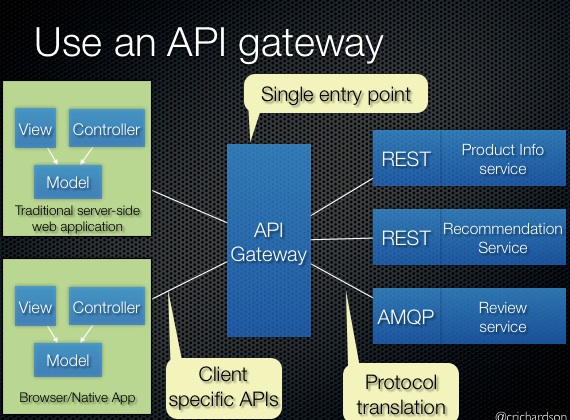https://microservices.io/patterns/apigateway.html

How do the clients of a Microservices-based application access the individual services?
Forces
- The granularity of APIs provided by microservices is often different than what a client needs. Microservices typically provide fine-grained APIs, which means that clients need to interact with multiple services. For example, as described above, a client needing the details for a product needs to fetch data from numerous services.
- Different clients need different data. For example, the desktop browser version of a product details page desktop is typically more elaborate then the mobile version.
- Network performance is different for different types of clients. For example, a mobile network is typically much slower and has much higher latency than a non-mobile network. And, of course, any WAN is much slower than a LAN. This means that a native mobile client uses a network that has very difference performance characteristics than a LAN used by a server-side web application. The server-side web application can make multiple requests to backend services without impacting the user experience where as a mobile client can only make a few.
- The number of service instances and their locations (host+port) changes dynamically
- Partitioning into services can change over time and should be hidden from clients
- Services might use a diverse set of protocols, some of which might not be web friendly
Solution
Implement an API gateway that is the single entry point for all clients. The API gateway handles requests in one of two ways. Some requests are simply proxied/routed to the appropriate service. It handles other requests by fanning out to multiple services.

Rather than provide a one-size-fits-all style API, the API gateway can expose a different API for each client. For example, the Netflix API gateway runs client-specific adapter code that provides each client with an API that’s best suited to its requirements.
The API gateway might also implement security, e.g. verify that the client is authorized to perform the request
Variation: Backend for front-end
A variation of this pattern is the Backend for Front-End pattern. It defines a separate API gateway for each kind of client.
In this example, there are three kinds of clients: web application, mobile application, and external 3rd party application. There are three different API gateways. Each one is provides an API for its client.
Examples
- Netflix API gateway
- A simple Java/Spring API gateway from the Money Transfer example application.
Resulting context
Using an API gateway has the following benefits:
- Insulates the clients from how the application is partitioned into microservices
- Insulates the clients from the problem of determining the locations of service instances
- Provides the optimal API for each client
- Reduces the number of requests/roundtrips. For example, the API gateway enables clients to retrieve data from multiple services with a single round-trip. Fewer requests also means less overhead and improves the user experience. An API gateway is essential for mobile applications.
- Simplifies the client by moving logic for calling multiple services from the client to API gateway
- Translates from a “standard” public web-friendly API protocol to whatever protocols are used internally
The API gateway pattern has some drawbacks:
- Increased complexity - the API gateway is yet another moving part that must be developed, deployed and managed
- Increased response time due to the additional network hop through the API gateway - however, for most applications the cost of an extra roundtrip is insignificant.
Issues:
- How implement the API gateway? An event-driven/reactive approach is best if it must scale to scale to handle high loads. On the JVM, NIO-based libraries such as Netty, Spring Reactor, etc. make sense. NodeJS is another option.
In our experience, we have realized that supporting these myriad device types with an OSFA API, while successful, is not optimal for the API team, the UI teams or Netflix streaming customers. And given that the key audiences for the API are a small group of known developers to which the API team is very close (i.e., mostly internal Netflix UI development teams), we have evolved our API into a platform for API development. Supporting this platform are a few key philosophies, each of which is instrumental in the design of our new system. These philosophies are as follows:
- Embrace the Differences of the Devices
- Separate Content Gathering from Content Formatting/Delivery
- Redefine the Border Between “Client” and “Server”
- Distribute Innovation